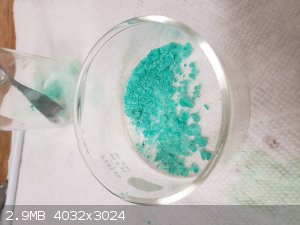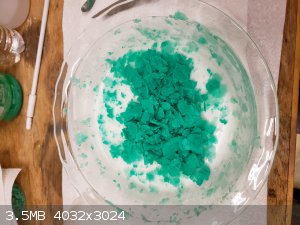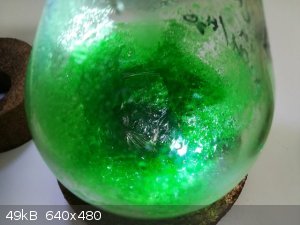metalayer
Harmless

Posts: 23
Registered: 7-7-2013
Member Is Offline
Mood: No Mood
|
|
Preparation of Nickel (ii) acetate
I'm looking to make Nickel (ii) acetate from Nickel (ii) Carbonate Hexahydrate. Is it as simple as adding an excess of acetic acid and stirring? Any
tips on technique would be welcome. Thanks.
[Edited on 3-11-2014 by metalayer]
|
|
|
Boffis
International Hazard
    
Posts: 1836
Registered: 1-5-2011
Member Is Offline
Mood: No Mood
|
|
Hi metalayer, it depends whether you want it as a crystalline solid or as a solution. The solution is easy, as you suggest you can simply dissolve the
nickel carbonate in an excess of cold, fairly concentrated acetic acid. If, however, you want it in a solid crystalline form it is altogether more
difficult. If the excess of acid is to small when you evaporate it down you get an insoluble basic acetate. Furthermore the change of solubility with
temperature is very small so cooling the solution to bring about crystallization is not practical. After much experimentation I found the best way is
to re-crystallise the basis acetate from 80% acetic acid. The basic acetate dissolves very slowly and requires several hours of simmering under a
reflux condenser to obtain a saturated solution. The excess basic/ normal but undissolved acetate is allowed to settle and the clear solution decanted
into a clean beaker, covered and then left to stand in the fridge for a month to crystallise which it does very very slowly! The clear green acetic
acid can then be poured off and recycled with another batch of Ni acetate. The crystalline tetrahydrate is filter washed with a little water and dried
in the air until it has only a slight acetic acid small.
Alternatively, if you have vacuum equipment the excess acid can be distilled of under vacuum until the slurry of nickel acetate that forms starts to
bump, cool and filter. The nickel acetate obtained by either process is completely soluble in cold water, the latter method gives a finer grained
paler less obviously crystalline product.
It may be possible to precipitate the soluble normal acetate by adding alcohol but I haven't tried this.
|
|
|
metalayer
Harmless

Posts: 23
Registered: 7-7-2013
Member Is Offline
Mood: No Mood
|
|
I need the solid, thanks for saving me a lot of time!
|
|
|
Mush
National Hazard
   
Posts: 632
Registered: 27-12-2008
Member Is Offline
Mood: No Mood
|
|
I agree with Boffis not easy to crystallize. I prepared it from black nickel oxide. (pottery grade) Black nickel oxide was dissolved in boiling 20 %
H2So4 . Reaction stars at the boiling point of the rection mixture (very violent).Dark green solution was filtered (unreacted nickel oxide remained
about 1/10 of original weight). Basic nickel-carbonate was precipitated with cc. solution of sodium carbonate as light green, very fine substance.
Vacuum filtered on Buchner funnel (very slow).The precipitate was washed with ion changed water until free from alkali.Thus obtained paste was
directly dissolved in 20 % acetic acid. Dark green solution was filtered to a glass lid of pyrex bowl.Water/acetic acid (acetic acid must be in
access all time during evaporation) mixture was evaporated on steam bath until thick green film formed on top of solution.It was Let cool down a
little bit.Equal portion of IPA was added. While still warm the whole mixture was transferred (with pipette) to a beaker and was put into a
refrigerator. Within 20 min, blue very small cube shape crystals formed.Crystals were vacuum filtered, washed with some IPA until most of the acetic
acid smell disappeared, air dried.Upon air drying (after a day) colour changed from blue to green.I used thus prepared nickel-acetate.4H2O for
Beckmann rearrangement. 2 times (blue acetate was used) rearrangement was succesful however 3rd time when green acetate was applied rearrangement
failed. I'm trying to find out if acetate is the problem.
|
|
|
Loptr
International Hazard
    
Posts: 1347
Registered: 20-5-2014
Location: USA
Member Is Offline
Mood: Grateful
|
|
Alright, so I prepared a solution of Nickel (II) Acetate in water using an excess of glacial acetic acid added to enough water to get the starting
Nickel (II) Carbonate into solution.
I slowly evaporated the solution in a beaker on a hotplate set to 130C. It's cold in there, so I don't imagine the solution was exposed to
temperatures anywhere near that due to cooling. Eventually I poured the slush onto a pie dish to finish drying on the hot plate.
However, now that the water is gone I am left with a blue-green mass around a center piece of yellowish mass. Is the yellowish mass the anhydrous form
of nickel acetate? It seems to be spreading out from the center of the pie dish where the heat would have been concentrated.
I am concerned that I have decomposed the Nickel (II) Acetate since I have read many different issues that pop up when preparing it, such as water
hydrolysis, or having to ensure that acetic acid is in excess at all times, etc., but I am just not sure how harsh the conditions must be for things
to go wrong.
1) I see a lot of talk about vacuum drying, or P2O5, etc., and am wondering what happens if you dry it in air around 100C?
2) What happens if you heat the solution strongly only for a time with a small excess of acetic acid to 200C+ without evaporating to dryness?
3) What is the yellow in the mass?
"Question everything generally thought to be obvious." - Dieter Rams
|
|
|
Loptr
International Hazard
    
Posts: 1347
Registered: 20-5-2014
Location: USA
Member Is Offline
Mood: Grateful
|
|
I do believe that I have the anhydrous form of nickel acetate. Most nickel salts are yellow when they are anhydrous, and this yellow-green color would
seem to fit the bill. The temperature to stay below seems to be 250C.
I am going to completely dehydrate it and try to rehydrate a small portion of it, and then try and grow tetrahydrate crystals from solution.
The yellow form is a lot easier to powder than the green crystals that are scattered throughout the mixture, so I will continue to heat and crush
with the bottom of a beaker until the color stops changing and I have a fine powder.
[Edited on 14-2-2019 by Loptr]
Here is an interesting site about growing nickel acetate crystals.
https://en.m.crystalls.info/Nickel_acetate
[Edited on 14-2-2019 by Loptr]
"Question everything generally thought to be obvious." - Dieter Rams
|
|
|
Abromination
Hazard to Others
  
Posts: 432
Registered: 10-7-2018
Location: Alaska
Member Is Offline
Mood: 1,4 tar
|
|
Do be careful, nickle salts are often carcinogenic. This is not a hazard in solution, but apon inhalation of the solid powder is hazardous.
List of materials made by ScienceMadness.org users:
https://docs.google.com/spreadsheets/d/1nmJ8uq-h4IkXPxD5svnT...
--------------------------------
Elements Collected: H, Li, B, C, N, O, Mg, Al, Si, P, S, Fe, Ni, Cu, Zn, Ag, I, Au, Pb, Bi, Am
Last Acquired: B
Next: Na
-------------- |
|
|
12thealchemist
Hazard to Others
  
Posts: 181
Registered: 1-1-2014
Location: The Isle of Albion
Member Is Offline
Mood: Rare and Earthy
|
|
Why would the salts be more dangerous as solid than in solution? Surely solution is just as dangerous as powder, since it is easier to spill and/or
absorb through the skin, if this is possible. Analogies with hexavalent chromium here.
|
|
|
woelen
Super Administrator
        
Posts: 7977
Registered: 20-8-2005
Location: Netherlands
Member Is Offline
Mood: interested
|
|
No, the solids are more hazardous. A solution does not give off any metal salts, only vapor of the solvent (in this case water and possibly some
acetic acid). Even if you spill the solution, there will be no release of metal salts into the air.
You will be surprised to see how many very fine particles can be released from a dry powder and become airborne. A nice demonstration of this is
working with KMnO4. Put your container of KMnO4 on a piece of white plastic. Transfer a spatula of the solid to a little beaker. Next, remove the
beaker and container of KMnO4 from the sheet of plastic and then take a wet towel and wipe the plastic. There is a good chance that you see many tiny
purple specs when the plastic is wetted.
If you heat a dry solid and stir the powder, many small particles are released. These can be inhaled. For this reason, when I use hexavalent chromium
salts, I prefer either using a pre-made solution, or using Na2Cr2O7.2H2O, which is hygroscopic and quite sticky. It does not release dust, in contrast
to K2Cr2O7. With dry nickel salts, which are not hygroscopic, the risk is similar.
It is not a matter of instant death in a bottle, but it is something to keep in mind, when you work with very dry finely powdered nickel salts
frequently.
|
|
|
Loptr
International Hazard
    
Posts: 1347
Registered: 20-5-2014
Location: USA
Member Is Offline
Mood: Grateful
|
|
The risk of air borne nickel powder is very real, especially when stirring the drying powder. I do see little whiffs of powder becoming airborne, no
matter how careful I am.
I was using a particulate mask, but maybe I will switch to a full face mask.
"Question everything generally thought to be obvious." - Dieter Rams
|
|
|
AJKOER
Radically Dubious
    
Posts: 3026
Registered: 7-5-2011
Member Is Offline
Mood: No Mood
|
|
As apparently US Nickel coins post the war years are 25% Ni (see https://coins.thefuntimesguide.com/pennies_nickels_silver_co... ), I suspect employing a US Nickel coin in a battery cell electrosyntheses
previously presented for CuO on this forum (see http://www.sciencemadness.org/talk/viewthread.php?tid=84047#... ) with an added high area carbon electrode (which is much more noble than Cu or
Ni) may eventually (after all the copper metal is removed) add some Nickel oxide to the copper oxide product mix!
Note, high Ni/Cu alloys (as used in cladding for coins) have a low anodic index (like only 0.15, see https://www.zygology.com/cms/upload_area/pdf/Zyg-Anodic-Inde... and hence there use in situations where high corrosive resistance is required),
and would not be recommended here as the high Ni/Cu electrode in such an experiment would have an anodic index much closer to that of carbon (which
should be presence with relatively greater higher surface area).
-------------------------------------
Add the appropriate acid to the metal oxide to form salts of interest, which would unfortunately required further removal of a copper salt presence,
but one is attempting a synthesis starting with a highly available cheap impure source (a US 5 cent coin).
[Edited on 20-2-2019 by AJKOER]
|
|
|
Loptr
International Hazard
    
Posts: 1347
Registered: 20-5-2014
Location: USA
Member Is Offline
Mood: Grateful
|
|
Here is a small pic from the latest bit of Ni(OAc)2 that I have prepared experimentally. I have a large amount of saturated solution to process still,
but I am now getting a solid that looks right.

[Edited on 21-2-2019 by Loptr]
"Question everything generally thought to be obvious." - Dieter Rams
|
|
|
Loptr
International Hazard
    
Posts: 1347
Registered: 20-5-2014
Location: USA
Member Is Offline
Mood: Grateful
|
|
Latest attempt with a larger amount of solution. It's still wet in this picture, and smells strongly of acetic acid.
I only seem to get crystal formation when the acetic acid concentration is very low or neutral. Acetic acid seems to keep more in solution. Crystal's
can form pretty quickly, but I dont know how long it would take to grow them to any considerable size.

I really like the color of this when it dries. It a pretty green with a hint of blue.
[Edited on 1-3-2019 by Loptr]
"Question everything generally thought to be obvious." - Dieter Rams
|
|
|
nimgoldman
Hazard to Others
  
Posts: 303
Registered: 11-6-2018
Member Is Offline
|
|
Here is my first attempt - still wet and really strong acetic acid smell:

I had only NiCl2, so I made solution, precipitated NiCO3 (basic) with Na2CO3(aq.), filtered and thorougly washed with water. I dissolved the basic
carbonate with excess of warm 20% acetic acid and proceeded to vacuum evaporation on rotavap.
The water bath temperature reached up to 80 °C and pressure was 160 mmHg.
The dehydration of nickel acetate tetrahydrate begins at 85 °C (80 °C under vacuum), lower than the boiling point of water/acetic acid.
This is why drying is done under vacuum unless you want the anhydrous salt.
It might be possible to air dry down to anhydrous salt (just keep the temp. way below 300 °C where melting and decomposition begins).
The anhydrous salt can then be redissolved in minimum amount of hot water and dried under vacuum below 80 °C. This should result in the pure
tetrahydrate without decomposition.
I need this compound for the production of Ni2B catalysts (P-1 and P-2) by reacting nickel acetate and sodium borohydride. Hence the need to get rid
of all the acetic acid - to prevent unwanted reaction of borohydride with AcOH.
I want to do all drying inside the rotavap - no fans or dehydrators because of the nickel dust.
|
|
|